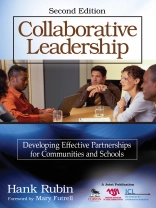‘Hank Rubin has fashioned a new and needed vision for collaborative leadership that can work anywhere—especially in schools. Rubin properly argues that public school success is not a top-down enterprise; it is a collaborative one. He reminds us that well-managed relationships and intentional collaboration are essential skills for all school leaders, from those teaching in classrooms to those running state agencies. This is a must-read for teachers and other champions of school policies and practices that support the success of every student.’
—John Wilson, Executive Director
National Education Association
‘Hank Rubin translates complex, contextually driven processes into digestible bites. The text is compelling, refreshing, and a joy to read.’
—Chris Ferguson, Program Associate
Southwest Educational Development Laboratory
‘Rubin′s book provides an eloquent and practical articulation of collaborative leadership and its potential to improve the partnership of communities and public schools.’
—Wendy Caszatt-Allen, Teacher and Author
Mid-Prairie Middle School, Kalona, IA
Build successful collaborative relationships in your school—and watch resources for student achievement soar!
Written to inspire and support educators in becoming transformative, collaborative leaders, this updated edition of a best-selling resource demonstrates how educators can use collaboration skills to help shape school culture and build and maintain strong schoolwide relationships that contribute meaningfully to students′ learning.
Visionary Hank Rubin provides a broad overview of collaboration in education and lays the foundation for working with colleagues, establishing strong partnerships, and cooperating with students to achieve goals. Updated with the latest research and filled with practical examples, this resource examines 14 phases of collaboration and helps educators:
- Understand the knowledge, skills, and personal characteristics necessary to foster successful collaboration
- Nurture relationships between students and the institutions and individuals associated with learning
- Build collaborative community relationships that support an instructional agenda
- Incorporate the study of collaboration and related reflective activities into leadership practice
By applying these vital principles of collaboration to their work, educators will discover what a school of collaborative excellence is capable of achieving!
قائمة المحتويات
Foreword to the Second Edition
Preface and Overview
Who Is This Book For?
Building Relationships for Children
A Note to Grantmakers
A Note on Writing a Book
A Quick Guide for the Reader
Dear Reader …
Acknowledgments
About the Author
1. An Invitation to Collaborative Leadership
Cutting Stone
Working Definitions
2. Collaborative Leadership: A Continuing Mandate
In Our DNA
The Importance of Powerlessness
The Position of Mission
The Monitor’s Dim Glow
3. Collaborative Leadership: If We Do It Right
Leveraging Leadership
Beyond Toolboxes
Collaboration and Competition
Collaboration and Creativity
Pushing String: Authenticity and Intentionality
So, Who Is a Collaborative Leader?
4. The Nature of Collaboration
Individual and Representational Participation
Types and Tones of Collaboration
Veracity and Tenacity
A Final Note
5. Most of Us Begin by Missing the Point: Why Education
Democracy’s Midwife
Supporting Education’s Civic Purpose
More Than Memory Banks
Content and Collaboration
Answering the Call for Public Collaborations
6. The 4th R
Looking at Teachers as Collaborative Leaders
Teaching Collaboration for Teaching’s Public Purpose
The Easy Case for Principals and Superintendents as Collaborative Leaders
A Final Thought
Schools and Colleges of Education
7. Constructing Models
The How
It’s All in Your Head!
Constellations-of-Relationships: Thinking Through Relationships
Collaboration’s Life Cycle
Overview
Phase 1: Why Collaborate?
Phase 2: Outcomes? Decision Makers?
Phase 3: Research: Knowledge, Policy, Politics
Phase 4: Stakeholders?
Phase 5: Frame and Recruit
Phase 6: Leaders, Structure, Roles, and Rules
Phase 7: Develop an Action Plan
Phase 8: Begin With Successes
Phase 9: Build Bonds Between Partners
Phase 10: Celebrate Successes
Phase 11: Assess, Adjust, and Reinforce Bonds
Phase 12: Goal-Centered Accountability
Phase 13: Scaffold the Change
Phase 14: Revisit and Renew Mission
Final Note
8. The Dimensions of Collaborative Leadership
Of Sums and Parts
The Value of Clusters
The Personal Dimensions of Collaborative Leadership
The Management Dimensions of Collaborative Leadership
9. Nine Nuggets
A Practitioner’s Postscript
Nine Principles of Effective Collaborative Leadership
Resource A: Planning and Assessment: An Intentional Q&A
Resource B: A New Conceptual Framework: A Tool for Teachers, Curriculum Developers, and Researchers
Resource C: “Schools of Collaborative Excellence”: A Model for School-Based Leaders
References
Index
عن المؤلف
Hank Rubin is president of the nonprofit Institute for Collaborative Leadership, former distinguished visiting scholar at George Mason University, and dean-in-residence at the American Association of Colleges for Teacher Education. He was previously joint dean of education at The University of South Dakota and South Dakota State University. With corporate, political, business, and nonprofit experience, Rubin is a nationally respected collaborative leader, educational spokesperson, and children’s advocate. Rubin’s work reflects the vision of one who sees the world through the eyes of a broad cross-section of those who influence the national, regional, and local partnerships needed to make sure that all children can succeed. He has taught seventh- and eighth-grade students, run three nonprofit organizations and created several others, directed and taught in the Midwest′s largest urban graduate school of public (government and nonprofit) administration, served as vice president for sales and marketing in an international manufacturing firm, served as associate vice president for institutional advancement in a large urban university, taught graduate students in education and business management, run for—and held—public office, and started and managed his own consulting firm before founding the nonprofit Institute for Collaborative Leadership.Rubin was an early researcher and leader in the field of nonprofit leadership. He was co-convener of the Clarion Initiative (a series of symposia that began at Harvard′s Kennedy School of Government and produced a framework that has guided nonprofit trainers, educators, and researchers since the 1980s). With more than 20 publications on topics including school reform, educational goal setting, public ethics, philanthropy, and nonprofit management, Rubin is a respected consultant, speaker, and advocate for innovative and collaborative approaches to leadership, training, and public education. He served as Ohio′s first associate superintendent for students, families, and communities and was a founding member of both the Ohio Learning First Alliance and the Chicago Panel on Public School Policy and Finance. Rubin earned his Ph D from Northwestern University and his MA and BA from the University of Chicago with early coursework at the State University of New York at Geneseo.












